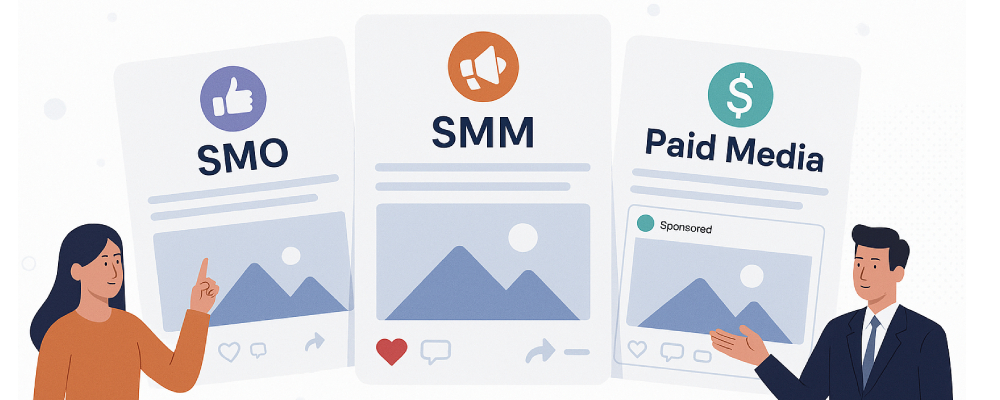2. What is SMO (Social Media Optimization)?
Let’s start with SMO — the base of everything.
Social Media Optimization is all about building and managing your brand’s presence organically on social platforms. There’s no money involved here — just smart use of strategy, content, and consistency.
SMO includes:
- Setting up your social profiles properly (bio, profile pic, username)
- Using relevant keywords and hashtags in your content
- Posting regularly with a clear brand tone
- Engaging with followers via comments, replies, and DMs
- Making use of platform features — stories, reels, polls, highlights
Basically, it’s the art of telling platforms like Instagram, Facebook, or LinkedIn: "Hey, this page is active, valuable, and worth showing to more users."
3. What is SMM (Social Media Marketing)?
Now, this is where many people get confused. Social Media Marketing is an umbrella term.
SMM includes both:
- Organic activities (which we call SMO)
- Paid campaigns (ads, boosts, promotions)
When you say you’re doing Social Media Marketing for a brand, it means:
- You’ve planned a content strategy (what to post and when)
- You’re optimizing your page (SMO work)
- You’re running ads through platforms like Meta Ads Manager
- You’re tracking analytics, engagement, reach, conversions
- You’re improving and adapting the approach over time
SMM is strategy + execution + performance tracking. It’s a complete marketing system on social media platforms that helps build brand awareness, engagement, and ultimately sales.
5. Let’s Simplify the Difference
| Term |
Full Form |
What It Includes |
Paid? |
| SMO |
Social Media Optimization |
Organic growth, profile setup, hashtag use, engagement |
No |
| SMM |
Social Media Marketing |
Organic + Paid activities combined into a full strategy |
Mixed |
| Paid Ads |
Meta/Facebook/Instagram Ads |
Running ad campaigns via Ads Manager to boost results |
Yes |
6. Why Understanding This Matters in 2025
Most brands are either doing too little or spending too much on the wrong thing. Here’s why this clarity matters:
- If you only run paid ads but ignore organic content, you burn money fast.
- If you only post content but never promote it, your growth is slow.
- If you don’t track what’s working, your strategy becomes guesswork.
In 2025, social media is more competitive, algorithm-driven, and content-heavy than ever. The brands winning are the ones doing smart SMM — not just dumping budget into ads.
7. Common Mistakes Brands Make
- Running ads without optimizing their profile first
- Assuming SMM means only ads
- Hiring someone to “just post on Instagram” without strategy
- Using the same content for all platforms
- Skipping retargeting completely
A good SMM approach always includes both creative planning (SMO) and performance media (Paid Ads). That’s how you build a funnel — not just temporary traffic.
8. What Should You Focus On?
If you're a beginner or small business:
- Focus first on SMO: fix your bio, post consistently, use platform features
- Build a clean, trustworthy profile that works organically
If you're ready to scale:
- Start running Paid Meta Ads in small budgets
- Track your top-performing content and promote it
- Use retargeting to convert interested users
If you're a D2C or service brand looking to grow aggressively:
- Build a full SMM calendar — mix content, campaigns, influencers, and tracking
- Invest in both storytelling and sales-driven content
- Understand your funnel — from reach to lead to loyalty
